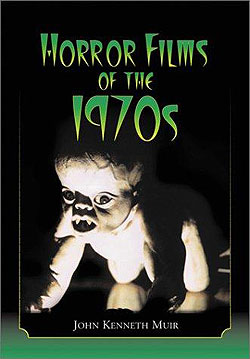Horror Films Of The 1970s, By John Kenneth Muir
Published on September 29th, 2011 in: Book Reviews, Books, Halloween, Horror, Movies, Reviews |
As a film fan, I’m an unabashed lover of the 1970s. In the introduction to Horror Films of the 1970s, film and television critic John Kenneth Muir describes why in two words: “savage cinema.” There truly was something different about films of that decade, and horror films of the ’70s are no exception. In fact, sometimes lines between horror and non-horror were blurred so successfully that it’s difficult to define the exact genres of films like Deliverance or Straw Dogs, both of which are discussed in Muir’s book.
Part of what makes the “savage cinema” so unique and thrilling, claims Muir, is that it presented viewers with a universe in which there were no answers. Yet, he quotes documentary filmmaker Adam Simon, who says that horror can be “open to the traumas of the world” in a way which will “naturally convey truths.” This nexus between no answers and universal truths is precisely why horror films of the 1970s are so unique and so thrilling.
Muir’s two-volume analysis of the decade’s horror films begins with an overview of the decade itself, an attempt to set the tone for what the ’70s were like, historically speaking. Most of the films covered are from the United States, so Muir focuses on the particular issues of the US as affected by international events. He follows this with another section about the prominent horror films and studios of the decade, which is interesting because it shows a time in cinematic history when multinational corporations did not own most of the major studios.
As for the films themselves, Muir covers goes through releases from each year in alphabetical order, providing cast and crew details, snippets of reviews, synopses, and finally, his own commentary. He also provides several appendices, a Top 15 list, notes, and an index. With over 225 movies reviewed, these two volumes are dense with information.
Thankfully, Muir avoids pedantic film school jargon and writes in a conversational, yet knowledgeable style. He intersperses his analysis and opinions of the films with analysis and opinions on societal and political issues, which is an interesting approach. Writing about 225 films with enough detail to prevent reader fatigue over 640 pages is an impressive task, and for the most part, Muir succeeds.
My biggest complaint about the book is the usage of the “star system” (one to four stars from worst to best, including half-stars) to rate the films. I tend to dislike ratings in film or music reviews for two reasons: 1) it is impossible to utilize such “objective” scientific methods when opinions on artistic merit are involved and 2) without a more precise rating or at least an explanation of what merits a “star,” reading the review makes such assignations seem arbitrary, especially when one three-star review is decidedly more negative (or positive) than another three-star review.
At times, Muir’s opinions on sociopolitical issues, though welcome, can get a bit heavy-handed. His tone and word choices are sometimes dated (I was surprised to learn that he is only a few years older than I am). It seems that he doesn’t favor religion very much, which is not presented in an offensive way, but it’s difficult to get past his distaste for violent video games, which comes across as somewhat old-fashioned. He also seems to be a bit fixated on describing female actresses or characters as “beautiful” to the point where the word loses its meaning. It’s possible he is using the term to explain how the character is supposed to appear in the film, but it is a little distracting.
Additionally, there are many glaring typos and inconsistencies in spelling within the reviews and almost-unforgivable overuse of ellipses. There are also several factual errors (a whale is a mammal, not a fish) which don’t affect the reviews themselves, but for one glaring exception. Although Muir gives 1977’s Demon Seed high praise, he completely omits a major plot point in both his synopsis and commentary, which is rather problematic because including that detail lends itself to a completely different reading of the film.
Naturally, I don’t agree with all of his opinions and ratings, which is to be expected; I agree with most of them, particularly regarding what he considers the best horror films of the decade (Carrie, The Exorcist, Halloween, The Texas Chainsaw Massacre). There are some gaps in reviews, but most of these (as Muir explains) are likely due to the films themselves not being readily available on either VHS or DVD. In some cases, he provides the briefest of descriptions of the films (The Brood, The Devils, The Reincarnation of Peter Proud); in other cases, he omits the films entirely (Don’t Be Afraid of The Dark).
Overall, Horror Films of the 1970s is a worthwhile read, particularly if one is looking for more recommendations from that time period. Despite the flaws, Muir has some excellent insights into the films, as well as the horror movie genre itself. In his commentary on Alice, Sweet Alice, he writes:
Some social critics might rightly ask how it is possible to praise this kind of utter explicit violence, but they would be missing the point. . . Frankly, that’s what horror should be about . . . Otherwise, what is death but an exclamation point to a car chase, an action scene, or a fistfight? It is not horror films that numb audiences to violence; it is the Hollywood flick that finds no terror, nothing extraordinary, in murder and mayhem.
To order a copy of Horror Films of the 1970s, please check out the McFarland Publications website or call their toll-free order line at 1-800-253-2187. You can also check out John Kenneth Muir’s website here.
Time limit is exhausted. Please reload the CAPTCHA.